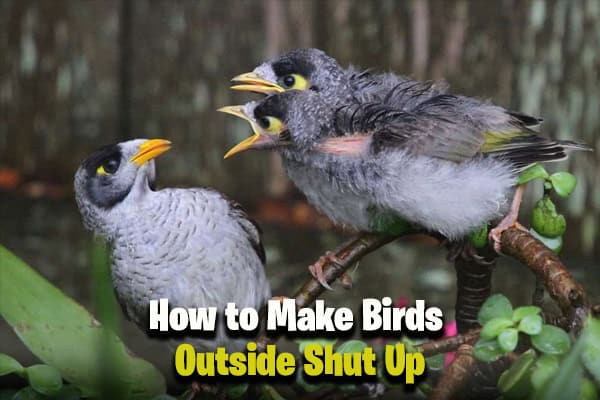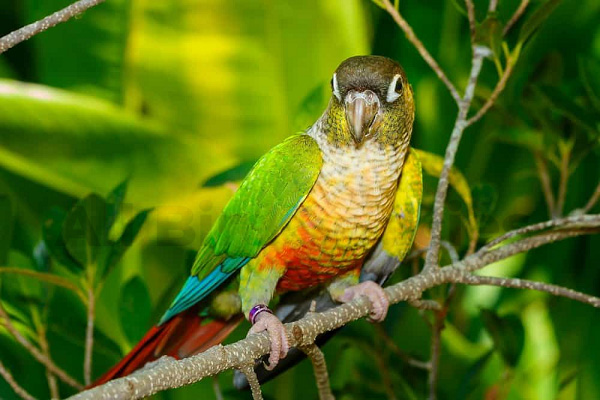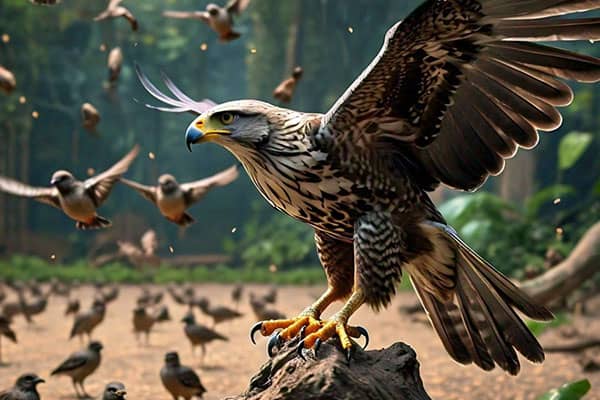15 Ways To Stop The Mess Under Your Bird Feeders
Do you get annoyed by the mess around your bird feeders? The mess there isn’t just unsightly. It can bring pests and even hurt the environment and the birds themselves. But, don’t worry. We have 15 great ways to help you keep things clean and make your backyard bird-watching better. Let’s learn how to make your feeding area neat for your flying visitors.

Challenges With Mess Under Bird Feeders
The space under bird feeders can get pretty messy. You might find scattered seeds, hulls, and bird droppings. Plus, there’s moldy stuff there too. Some birds pick through the seeds and spit some out. This adds to the mess. What’s more, this mess attracts unwanted guests like rodents, and this can be bad for our health.
Types Of Mess
Bird feeders can leave behind different types of mess. You’ll see spilled seeds, bird droppings, and even mold. If the area is covered in gravel, it makes cleaning harder. Seeds mix in with the gravel and are tough to clear away. And suet powder from mesh feeders only adds to the mess.
Damaging Effects
The mess under bird feeders isn’t just unsightly. It can bring in pests like rodents. Plus, the droppings and mold could be harmful. They might cause health problems. It’s important to clean regularly to avoid these issues. This keeps the area safe for birds and bird lovers.
Importance Of Cleanliness
Keeping the area under bird feeders clean is important. It stops diseases like salmonella from spreading. And it helps keep pests away. A tidy area is also more welcoming for your flying friends.
| Types of Mess | Damaging Effects | Importance of Cleanliness |
|---|---|---|
| Scattered seeds and hulls Bird droppings Moldy debris | Attract rodents and pests Potential health risks | Prevent disease spread Deter pests Maintain an inviting space |
Bird Seed Management Tips
Making sure there’s the right amount of bird seed in your feeders is key. Too much seed makes a mess, attracting pests.3 But, too little would mean refilling often and not enough for the birds. The goal is to watch and fill the feeders regularly, not too much, not too little.3
Optimal Seed Quantity
Finding the perfect amount of seed is important. Don’t overfill, as it wastes seeds and makes a mess.3 Check the feeders often and add more when needed. This way, the birds get what they need without extra mess.
Selecting The Right Type Of Seeds
The kind of bird seeds you pick can also reduce mess. Choose no-waste mixes without shells.3 These mixes are all edible, making them a better choice. You won’t be paying for what the birds can’t eat.3
Alternative Seed Dispersal Methods
If your regular feeders are still messy, try new ones. Hopper, tray, tube, and mesh feeders are good choices for no-waste mixes.3 These feeders are designed to keep the mess to a minimum around your feeders.
Feeder Placement Strategies
When choosing where to put your bird feeders, think about putting them over easy-to-clean surfaces. This can mean gravel or mulch, not grass or concrete. Also, place them close to trees and shrubs. This helps birds perch naturally and reduces mess on the ground.
Suspension And Elevation Techniques
Hang your feeders or lift them off the ground to keep things tidy. With the feeders up higher, less seed and hulls collect on the ground. Plus, this keeps away animals you might not want around. Choosing the best feeder type and methods to hang or lift them can keep your feeding area neat and orderly.
Impact Of Surrounding Landscape
The area around your feeder matters too. Plants that seeds-loving birds enjoy can lessen the mess. This provides a spot for birds to look for dropped seeds as well. Also, using ground cover like stone can make the ground look better. It hides seeds and hulls, making the area neater.
| Feeder Placement Strategies | Key Considerations | Potential Benefits |
|---|---|---|
| Strategic Location Choices | Placing feeders over easy-to-clean surfaces like gravel or mulch, and near natural bird habitats | Facilitates efficient cleanup, encourages natural perching, and reduces ground spillage |
| Suspension And Elevation Techniques | Elevating feeders above ground level, using the right feeder design | Prevents seed and hull accumulation, deters unwanted visitors, and maintains a cleaner feeding area |
| Impact Of Surrounding Landscape | Planting seed-loving plants, using ground cover like stones or pea gravel | Provides natural foraging options, hides dropped seeds and hulls, and enhances the overall aesthetic |
Thinking about where to place your bird feeder can make your yard look nicer. By following these strategies, you can keep the area clean and attractive.
Innovative Feeder Designs
Choosing the right bird feeder design can help keep the area underneath clean. Many innovative features make this possible. Let’s explore some of them.
Mess-controlling Feeder Features
Bird feeders with seed-catching trays are great because they stop spills. This design makes cleaning up very easy.
Adjustable perches and weatherguards can also reduce waste and keep things tidy. Plus, some feeders have special parts that push waste away from the feeder.
Tray and Tube Feeder Alternatives
Mesh-bottomed and skirt feeders are a good change from the typical designs. They let birds get to dropped seeds without a big mess.
These types of feeders often have angled perches and special systems for dealing with waste. This helps keep the area around them cleaner.
Squirrel-resistant Options
Squirrels can make a mess around bird feeders. To fight this, consider feeders that squirrels can’t open. Options include feeders that close when something heavy, like a squirrel, lands on them. Also, there are feeders with baffles to confuse squirrels, and feeders with multiple levels that also lock securely are good choices. They all work well to keep the feed for the birds clean.
Effective Cleaning Methods
Keeping your bird feeding station clean is key for your birds’ health. Use the right tools for an easy cleanup. Clean weekly to stop seed build-up, mold, and pests. This also makes birds easier to see when they come to eat.
Tools & Resources For Easy Cleanup
There are many tools to make cleanup easier, from special cleaners to ground covers. Using selective feeders reduces wasted seeds. Timing your refills can make birds eat more neatly. Seed catchers and no-waste seeds prevent mess on the ground. Elevated feeders and others help keep things tidy.
Regular Maintenance Routines
Having a set cleaning schedule keeps your bird area neat. Cleaning with bleach should take around 15 to 20 minutes, and with vinegar, a bit over an hour. Seed and suet feeders need cleaning every two weeks, more often in damp weather. Change the sugar water in hummingbird feeders every few days if it looks cloudy.
Eco-friendly Waste Disposal Practices
Think green when getting rid of waste. Use features like seed catchers and no-mess seeds to cut down on trash. Also, planting seed-friendly plants under feeders can help. Clean feeders with a diluted bleach solution for 10 minutes. Dry them on a towel before refilling. Always wash your hands after handling feeders to avoid bird-borne diseases.
These cleaning, maintenance, and disposal tips help keep your bird area nice. This is good for your birds and the environment.
Mess Under Bird Feeders
Bird feeders add charm to gardens by bringing in beautiful birds. Yet, they can cause a lot of mess. Knowing about the mess, its harm, and the value of staying clean is key to handling the issue.
Under feeders, you might find seeds, hulls, poop, and old bits. This messy area can invite pests, making it unsafe. Keeping the area tidy is vital for birds’ health and enjoying bird watching.
Cleaning up spilled seeds can be hard, especially if the wrong types are used. Everyone’s looking at using sunflower hearts to stop messes and seed growth.
Using trays under feeders cuts down on mess, say all families. Also, they choose no-mess seed mixes. They’re very happy with how these solutions work.
Regular cleaning is a must, with everyone doing it daily. All pick concrete under feeders for easier cleaning.
Goldfinches are known for throwing seeds around, as are pigeons and starlings. Placing feeders on gravel needs more cleaning, risking lawn damage.
The more Goldfinches, the more mess. Using sunflower hearts with black seeds lessens waste. Trays under feeders help but need cleaning to keep pigeons away.
Rotting seeds can lead to fungus. Paving under feeders makes cleaning easier. Ground feeding can also limit mess.
Standard bird foods have messy shells. But, no-waste mixes are all edible.3 They stop weeds by not letting seeds sprout.
Bird lovers like Lyric’s no-waste mixes. They use special feeders to keep seeds safe from the weather.

Ground Cover Options
Choosing the right ground cover can help keep the area under bird feeders clean. You might want to use stones or pea gravel to cover the ground and hide the seeds and shells. A seed tray is also a good idea to reduce mess and bring more bird kinds. Lastly, placing a hardware cloth or screen under the feeders makes cleaning up easier.
Stones or Pea Gravel
Experts suggest using rocks like pea gravel or white granite to a 2-inch depth. This approach hides the seeds and droppings well, making your bird feeding area look neat. It’s a low-maintenance way to deal with mess.
Seed Trays
Placing a seed tray under your feeder is smart. It cuts down on the mess and lures more birds with its convenience. The tray catches the stray seeds, keeping the ground cleaner. This not only reduces the mess but also maintains a bird-friendly and tidy space around your feeders.
Hardware Cloth or Screens
A hardware cloth or screen is another great trick for cleaning bird-feeding areas. This method lets seeds and debris fall through but stops bigger items from messing up your space. It makes picking up around your feeders much easier and prevents clutter.
Attracting Different Bird Species
Bird feeders bring a variety of birds to your yard. Use the right seeds and place your feeders well. This makes different bird types feel at home, adding to the joy of watching them.
Starlings might bully other birds at the feeder. Use more than one feeder to spread them out. This way, everyone gets a fair chance at the food they love.
Many birds like different meals. Try various seeds like sunflower and safflower. Mix in millet seeds, cracked corn, wheat, and peanut chips to attract a wide range of birds.
For the safety of smaller birds, crush peanuts. Guardian feeders protect against starling bullies. They make room for more bird varieties.
Keep your feeding area clean to avoid rats. Use different feeders like tubes, hoppers, and trays. These will invite more bird types over time.
Plants and woods nearby bring even more birds. Mixing in guardian feeders also helps. They protect little birds and balance out the community.

Managing Unwanted Visitors
Keeping your bird feeding station clean and welcoming is key. But, it’s important to deal with unwanted visitors like squirrels. They can cause a lot of trouble by stealing food and making a mess. To handle this, look into squirrel-proof feeders, baffles, and guards, and ways to keep them away.
Squirrel-proof Feeders
The best way to keep squirrels at bay is with specially designed feeders. These usually have a mechanism that closes when a squirrel jumps on it. This stops them from getting the food. Feeders with cages or smart designs can also help keep squirrels off.
Baffles and Guards
Using baffles and guards can also work well. Baffles are placed on the pole, making it hard for squirrels to climb up. A wire fence set up 3 feet from the feeder pole keeps out deer. Hang feeders under something, like an awning, to make them harder to reach.
Deterrents and Repellents
If squirrels are still a problem, you can try deterrents and repellents. Putting a wire hoop with lines around the feeder might scare off some squirrels. Even changing the feeder design to make it harder for squirrels to eat might help. By using a mix of these methods, you can keep squirrels and other pests away from your feeders.
Seasonal Considerations
Managing the mess under bird feeders means thinking about how each season affects your routine. Cleaning needs and the way you handle seeds might change based on the time of year. To keep your outdoor space welcoming for birds, adjustments are key.
In spring, you should slow down on feeding birds by April or May. This is when nature offers a lot of food. Still, you might want to offer insects and berries. Giving them high-energy seeds and nectar is good if food is scarce.
Summer brings a lot of natural food. Despite this, adding extra food is still helpful. High-energy seeds and nectar can be offered sparingly. There’s no set time to stop this in the summer.
Into autumn, the focus turns to helping both those who fly away and those who stay. Birds like swallows and house martins are getting ready to leave, so they need extra food. It’s also a crucial time for resident birds to prepare for winter. By late October or November, stop feeding birds to help them adjust to colder conditions.
Adjust your cleaning and feeding habits according to the season. Doing this creates a space birds will find welcoming all year round.
Check Our Previous Articles
| Birds in South Carolina |
| Wrens In Ohio |
| Falcons In Texas |
| Hummingbird Migration Map Guide |
| Hummingbirds In Virginia |
Balancing Aesthetics and Function
It’s important to make the area under bird feeders neat and useful while keeping your outdoors pretty. Balancing aesthetics and function is tricky, but it can be done with smart choices. You’ll make a lovely place to watch birds, and it’ll stay clean.
Using special feeder designs, like the EcoTough Classic made from recycled materials, makes your yard beautiful. Feeder placement near natural perches reduces mess. And, choosing attractive feeder accessories that work well is key. Think of the decorative APS hardware in cinnamon and black.
Regular cleaning and maintenance are crucial. Items such as seed catchers help with this. They keep the area clean and preserve its beauty. Balancing aesthetics and function means creating spaces that meet birds’ needs and look great.







